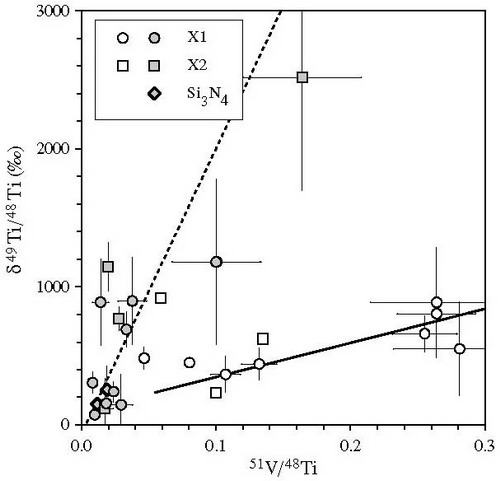|
News
|
2010
Astrophysical Journal:Supernovae Materials from the Qingzhen Enstatite ChondriteMeteorites are the "fossil" of the solar system, and the most primitive chondrites even preserve materials before the formation of the solar nebula, so called presolar grains. The presolar grains are micron to submicron-sized, and originated from various stars, including supernovae, red giant and asymptotic giant branch stars. They are the only available extrasolar samples that can be analyzed in laboratory, hence serve as a window for evolution of stars and the formation of the solar nebula. Dr. Yangting Lin, from the Key Laboratory of Earth's Deep Interior, institute of geology and geophysics, Chinese academy of sciences, carried out a systematic study of presolar grains separated from the Qingzhen enstatite chondrite, by cooperating with the McDonnell Center for Space Sciences, Washington University. After the discovery of a large number of presolar SiC and Si3N4 grains from Qingzhen, they analyzed isotopic compositions of Al, Mg, Ca, Ti and V of the X grains that came from Type Ⅱsupernovae, with NanoSIMS. The new data indicate common presence of short-lived 26Al (half-life of 0.74 Ma), 44Ti (half-life of 60 year), 49V (half-life of 332 days) in these X grains, confirming their origin from Type Ⅱsupernovae. These grains were divided into subtypes X1 and X2 based on isotopic compositions of C, N and Si reported in their previous study, and the inferred 44Ti/48Ti ratios confirmed the difference between subtypes X1 and X2. Using available data of Type Ⅱsupernovae, they carried out mixing simulation and compared the results with the analyses. The simulation can explain the C and N isotopic ratios fairly well, and the different 44Ti/48Ti ratios between the subtypes X1 and X2. In addition, they showed that not for all grains the 49Ti excesses can be attributed to decay of 49V and material from the He/C zone, where 49Ti is produced by neutron capture, is possible. However, the SN models fail to account for the inferred 26Al/27Al ratios in connection with the 12C/13C and 14N/15N of the grains, and the Si isotopic compositions of the X1 grains.
Isotopic Compositions of V and Ti in X grains. 49Ti excesses is positively correlated with the V/Ti ratio,which can be attributed to decay of 49V. The slope of the regression line are inferred to 49V/51V ratio that is significantly larger for the X grains from the Qingzhen enstatite chondrite (filled symbols) than those from other meteorites (open symbols, cited from literature). The original paper was published in the Astrophysical Journal (Lin et al. Isotopic analysis of supernova SiC and Si3N4 grains from the Qingzhen (EH3) chondrite. Astrophysical Journal, 2010, 709: 1157-1173).
|
-
SIMSSecondary Ion Mass Spectrometer Laboratory
-
MC-ICPMSMultiple-collector ICPMS Laboratory
-
EM & TEMElectron Microprobe and Transmission Electron Microscope Laboratory
-
SISolid Isotope Laboratory
-
StIStable Isotope Laboratory
-
RMPARock-Mineral Preparation and Analysis
-
AAH40Ar/39Ar & (U-Th)/He Laboratory
-
EMLElectron Microscopy Laboratory
-
USCLUranium Series Chronology Laboratory
-
SASeismic Array Laboratory
-
SEELaboratory of Space Environment Exploration Laboratory
-
PGPaleomagnetism and Geochronology Laboratory
-
BioMNSFrance-China Bio-mineralization and Nano-structure Laboratory


